Articles
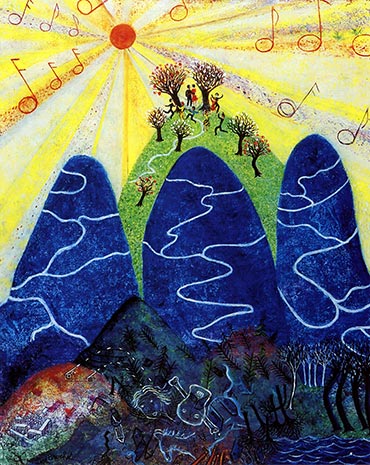 "Du chaos à la sérénité" de Lise Brachet
"Du chaos à la sérénité" de Lise Brachet
Table ronde « Jeunesse universitaire »
entre Serbes, Croates et Bosniaques
UMJETNICKA GALERIJA
Zelenih Beretki 8, Sarajevo, Bosnia-Herzegovina
Konrad Adenauer Stiftung, Sarajevo
Fondation Fridtjof Nansen Sarajevo
IMIC, Sarajevo
03.11.2001
Dans le cadre de l'Exposition Photos :
« Sur les pas de Moshe-Moses-Moussa »,
Novi Hram Galerija, Sarajevo, B&H, 2003.
Ouvertures a.s.b.l., Annelie Löhr-Campion, Belgique
Thème :
« Moshe - Moses - Moussa » in jüdisch-christlich-islamischer Tradition
Lire aussi « Exposition-photos à SARAJEVO »
La guerre de Bosnie à provoqué le déplacement de plus de la moitié de la population bosnienne. Une purification ethnique a eu lieu. On comptait fin 1995 3 millions de personnes déplacées, 300.000 morts et disparus, 10.000 pour la seule ville de Sarajevo.
Vous les jeunes, bousculez ce monde et allez vers l'Universel, devenez hommes et femmes universels portant en vous et à travers vous l'Humanité toute entière qui lui vient depuis la nuit des temps.
L'essentiel est que nous sommes comme les grains d'un chapelet, chacun individuellement mais reliés par un fil, ce fil c'est l'esprit qui anime tout être humain. Celui qui voit l'humanité dans cette perspective, qu'il fait partie d'un Tout, et qu'il n'est en fait qu'un instant dans le Temps.
Cheikh Adlen Khaled Bentounes, Algérie
Maître soufi de la tarîqa 'alâwiyya
Président d'Honneur de l'Association Internationale AISA
Discours aux "Rencontres au service de la Paix", Bruxelles 1997
Cliquez pour agrandir...
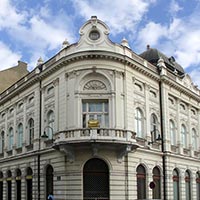 |
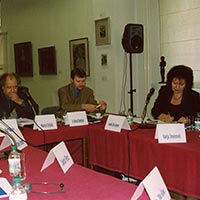 |
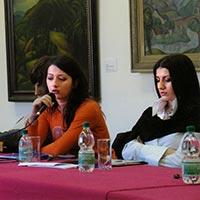
|
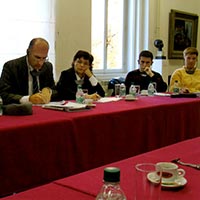 |
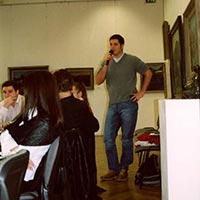 |
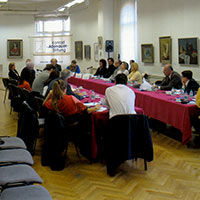 |
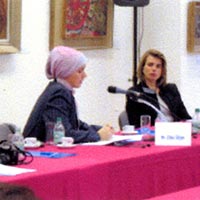 |
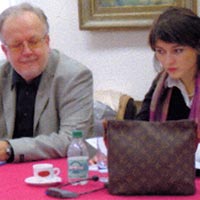 |
Table Ronde "Jeunesse universitaire" entre Serbes,
|
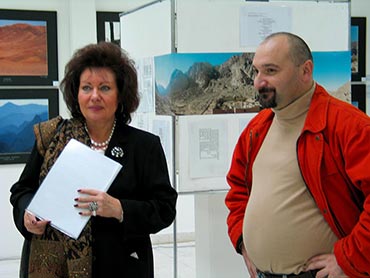 Mme Campion, M. Nebojsa Savija-Valha, Fondation Fridtjof Nansen, Sarajevo, Bosnia-Herzegovina.
Mme Campion, M. Nebojsa Savija-Valha, Fondation Fridtjof Nansen, Sarajevo, Bosnia-Herzegovina.
Interview with Nebojsa Savija-Valha
Nebojsa Savija-Valha, Nansen Dialogue Center, Sarajevo, Bosnia
I’ve done work in a number of different fields here in Bosnia. I play music and perform in the cultural association Ambrosia. I am a co-founder of the jazz festival here in Sarajevo. I am a founding member of the organization Musicians Without Borders Bosnia and Herzegovina.
On Peacebuilding
And I work for a local organization on peacebuilding and prevention of conflict that is connected to similar centers in all the former Yugoslav republics except Slovenia. This is the Nansen Dialogue Center, and it is named after the Norwegian explorer Fridtjof Nansen. Nansen was a Nobel Peace Prize winner who served as the first commissioner for refuges in the League of Nations between the two world wars. The Nansen Academy in Lillehammer began a school in 1995 to train people in conflict regions in democratization, peaceful conflict resolution, and human rights. The people who attended these courses then established centers in the Balkans, and the whole project (until now) has been supported by the Norwegian foreign ministry. The main focus has been interethnic dialogues. Whatever the topic, the discussion must include people from different ethnic backgrounds.
We started here in 2000. In the beginning we worked with different target groups, in Sarajevo, in Banja Luka, in Mostar, and now we are working in Srebrenica and Bratunac. These are two neighboring municipalities with very tough war legacy and difficult political and economical situation, but also with a lot of returnees.
We are working with municipalities, helping to improve interethnic dialogue between the institution and returnees. Also we have been working in the divided schools there, trying to unite – transform some monoethnic schools into multiethnic schools. Finally, we hold sessions with youth from the region on facing the past and transforming the future.
When we started working in the municipality of Bratunac, it was very divided on ethnic issues, on political issues. The municipality was suspicious of us as another organization coming from the capital that was trying to “profit on its position.” We were perceived as an intruder, and we faced obstructions from some municipal leaders. But then, with persistent work, and continuous traveling and presence of our staff, we somehow managed to succeed in this environment. Our image started to change. Doors started to open. One year after going there, we formed two coordination bodies with municipal counselors, with representatives of returnees and of different public institutions. These bodies were ethnically mixed and to some extent gender balanced. We are still living in the framework established by the previous regime in which a higher body makes decisions, not the people themselves. But now this representative committee is making its own policy. We sit down and talk to them about their plan, we facilitate and push a bit here and there, but this agenda and this work is their accomplishment.
In our school project, when we started, the students were kind of prisoners in their own schools. There was a main school in a village that was Serbian, and a field school in a village 10 km away with Bosniak returnees. Some students travel 20 kilometers each day to attend monoethnic schools while having a school in their neighborhood – but the one that “belongs” to the other ethnic group. The teachers were the same – they traveled back and forth between the schools – just because the curricula were different. So we organized a seminar, training for teachers and school administrators. Before this engagement, there was a single Bosniak teacher. Now five Bosniak teachers are employed, so this is the first indication that something has changed.
We encountered severe opposition from the parents, however. It wasn’t that they didn’t want to create multiethnic schools. They expressed in conversations that they did want to. But they were afraid of their own groups, of being labeled traitors. Maybe in this other school there are children of parents who committed crimes during the war and they don’t want to mix children with those of perpetrators. There are some instances of people who profit from the division, like organized crime, and maybe we were challenging that vested interest. These people are poor, they are barely surviving and still they have to pay a lot of money for transportation to send their children to a distant school. So we suspect that this money is provided from informal sources.
At first we couldn’t get in touch with parents. We could meet them at their houses, but when we organized joint activities, only one or two would show up. At the end of the first year, we invited parents to jointly rebuild classrooms, one in each school where we promised to hold two extracurricular courses: an IT course run by a Bosniak teacher and an English course run by a Serbian. The students in these courses were supposed to be mixed. And we were very surprised when parents appeared, even those most opposed to our activities. They got together and rebuilt the classrooms. And then last November, these classes started with mixed students.
As a deliberate strategy, we really don’t publicize what we are accomplishing. It might create problems within communities. We try to be low profile, doing the job at a more-or-less grassroots, “subversive” level. The media is not so interested in us. There’s no blood, no violence. Quite the contrary: we offer them only “boring” stories. We are only a small local organization, not Transparency International, not Helsinki Watch. Of course, our low profile has turned out to be a problem when we are trying to get more funds.
On the Youth
In 2005, we organized dozens of round tables dealing with many relevant issues. And we discovered that the worst chauvinists and nationalists are coming from the youth. They are growing up in monoethnic environments, they don’t have experience of others. They were born during the war or immediately after, so they don’t have the experience of multiethnicity as we do. So, we try to figure out how to deal with this. The first thing we decided was to face them with the past. At the beginning of the seminar, we thought it would be terrible because the young people were fighting all the time. With elders, you have a hard time addressing conflict, because there is a tendency to repress conflict, at least in everyday situations. But these young people were fighting all the time. In the end, though, some things happened. They started to listen to the other side. And they started to talk to each other without us being the facilitators.
We’ve seen in this municipality that Bosniaks are joining NGOs that previously were only Serbian and gathering at cultural centers that previously were only Serbian. It might not be a quantitatively huge, but in the given situation, it is really a success. The very fact that the Srebrenica municipality signed an agreement with us to work for five years on interethnic issues, and that a similar agreement is to be signed in Bratunac, is somehow a signal that we are on the right track. We are not building houses; we are building neighborhoods.
On Ethnic Groups
There is a tendency here for people to move toward ethnic centers. This has never happened before in Bosnian history. The country has become more ethnically divided than ever before. Sarajevo is Bosniak, Banja Luka is Serb. There are, however, some pockets of multiethnicity. Regardless of the crimes that took place, people are coming back. And that includes some young people, not just old people. We need to somehow help these people to stay, to work, and to live together. There are not enough funds for split communities, divided schools, divided everything. We have to integrate to survive. This is very pragmatic. We don’t talk about who is to blame. We want instead to identify their interests. Maybe in a generation or two, these interethnic networks will be rebuilt. It will take longer than two or three years, longer than a particular funding cycle. It’s like building democracy – there’s no “democracy powder” that you can put in water and then have instant democracy.
On Colonialism
We are not just a post-communist society, we are a post-colonial society. Things here were always run from the outside – from the Ottomans, from the communists. We don’t know how to run ourselves. We have to make the shift, from passive to active, from patriarchal to citizen-based. It can’t be done in Washington or from Brussels – only from within the society. And we can’t do this job from Sarajevo. So our coordinators are staying in homes in these communities, talking with people, taking notes. We adjust the programs based on this feedback. We’re always learning from the community. In some cases we know the community better than the people in the community because we are partly outsiders with access to both sides. This gives us a better position to be helpful to the communities.
On Conflict
Bosnia-Herzegovina was a society completely without conflicts. This was the subject of my master’s thesis, how the creating of ethnic identity was part of this process. In everyday situations, we don’t know what conflict is. To establish everyday communication at a trans-ethnic level, you have to exclude conflict in the community. You set up all sorts of mechanisms in the community to avoid conflict. One mechanism to deal with conflict is humor. You put quotation marks around everything and then it’s okay. We created the ironical subject, making jokes and suppressing personal investment in order to equalize the heterogeneous aspect of the society, to make the community functional at the least common denominator. Yet, one can not simply destroy the conflict, or potential energy of the conflict. It is against the natural law of energy preservation! It has always been given to “higher” instances to resolve it. They were local elites, or the “colonial power” was the ultimate “conflict manager”.
Once the “colonial power” disappears, a society structured in this eccentric way starts to fall apart. The colonial power kept everything in control. It disappears, and centrifugal forces go to work. Clashes break out.
On Music
I grew up in the 1970s. As a teenager, I grew up with punk. When I heard the Sex Pistols played, I immediately switched from rock to punk. This identity is my primary identity. When I was growing up, I didn’t think of myself as Bosnian, Serb, or Croat. I’m also an atheist, so I don’t have a religious identity that goes along with the ethnic or national ones in this region. I’m just punk.
My original and the first organization, Ambrosia, performed art from Italy to Norway and in all the countries of the former Yugoslavia. But we rarely performed here in Bosnia. We developed during and immediately after the war, and it was possible to get cheap performance space and equipment. But the music scene quickly became commercialized. It became difficult to support grassroots activity. Here, otherness is always dangerous, whether it’s ethnic, religious, cultural, or something else. Punk, anarchist, homosexual – whatever is different is dangerous. It’s difficult to develop an alternative scene here because of this perception.
We have four “departments” in Ambrosia. The musical department does experimental music (free jazz, contemporary music, ambient, etc). And then there’s the dance and theater department as well. And we have a label called the “text pathology department” in which we write and publish everything from poetry to humanistic writing. We have a huge amount of documentation from our more than 120 performances.
The Sarajevo jazz festival started in a café bar among three people: the current director, my brother, and me. We knew almost all the people in the city who were fond of jazz. There had been just few of them. Despitethis, in 1998 we decided to organize an international festival, which became probably one of the strongest jazz festivals in the region in the last several years. From approximately 200 people on average in the audience, mainly foreigners, in 1998 we grooved up to a festival held in five halls with sold-out concerts, attended by the majority of the local audience. And most of the top jazz musicians from all over the world played here.
The conflicts here are also reproduced at the level of music. People sing all kinds of folk songs: Serb, Bosnian, Croat. That shows you that trans-ethnic communication is possible. At the same time, however, it reproduces the division. For example: “sevdalinka” is a typical song from Bosnia Herzegovina. It’s a mixture of Oriental, Jewish, and folk music from here. But in practice it is always perceived, incorrectly, as a Bosniak or Muslim song. So people sing songs associated with other groups and have no problem singing them, but they are always aware that they are singing the music of the other. Another important ethnological issue about folk music in particular: This music is based on the reproduction of the social ties of traditional community – patriarchal, tribal, anti-modern, and conservative. So it includes the preservation of a “folk spirit” in its “pure” form that resists the cultural shift toward modern democratic society, and doing so it helps maintain the status quo that also includes clear ethnic division.
I believe that the fine and alternative arts should be seen as part of the healing process of society.
Interviewed in Sarajevo, May 2008.
John Feffer
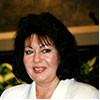 |
Organisation : Ouvertures a.s.b.l., Annelie Löhr-Campion, Belgique ouverturesforpeace.eu |




